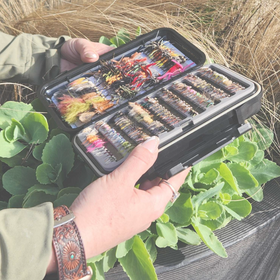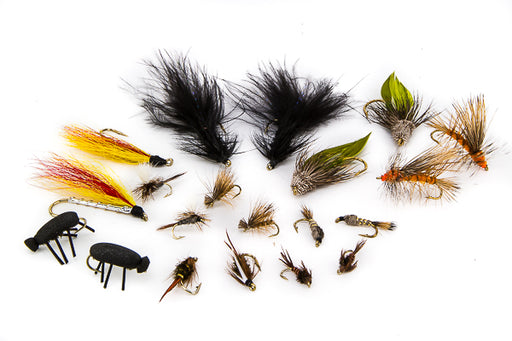
Fly Fishing Stillwaters with Midges
Lakes, ponds, impoundments, reservoirs that have healthy trout populations, probably have healthy midge populations as well. Midges are like nature’s trout candy store that is always open. They will hatch daily, rise daily, suspend daily. When you arrive at your favorite still water you will most likely see no real activity to key you in on how to fish it. If you do see rise circles or some subtle rises, consider yourself lucky and tie on a midge adult and settle in for some great dry fly action. Besides a rising trout your next best indicator might be your vehicle. If it is covered with midge splatter from driving in or you are constantly brushing them off you or your gear, watch the water some more. The takes can be extremely subtle and careful observation is many times required.
If you notice swirling activity just below the surface or even fins poking through the surface, then trout are feeding on suspended midge pupae. The surface tension of the water creates a barrier that must be penetrated by the pupae. Midge pupae do this one of two ways, they either repeatedly pop into this barrier with their heads or hook through tail to the surface and pull themselves through. Whichever process an individual midge uses, it takes time to break through. This pause from their ascension makes them extraordinarily vulnerable to swirling trout.
If none of the above is going on, do not despair. If there are trout in your chosen still water, then there are midges below. Midge larva emerge from their burrowed homes in the muck to once more avail themselves as pupa before they ascend. The trick here is to determine proper depth, which can easily be done from a float tube with an anchor or by tying pliers or forceps to leader and dropping them over. Remember to allow 18” for vegetation growth and then place your strike indicator at the right depth. If your fly keeps getting vegetation then shorten your leader. The pupa will hang right at the top of the vegetation.
As seen on ths article
Shop more-
Adams Fly Assortment--24 Flies #1
$19.32Original priceOriginal price $19.32 - Original price $19.32Original price$19.32 - $19.32Current price $19.32| /24 flies in the Adams family Patterns included are: Adams Adams Female Adams Wulff Comparadun Adams Adams Extended Body Parachute Adams Flies w...
View full details$19.32Original priceOriginal price $19.32 - Original price $19.32Original price$19.32 - $19.32Current price $19.32| /Value must be grater than or equal to 1. -
Alaska Guide Selection - 42 Flies - Umpqua
$99.95Original price $144.95Original price $144.95 - Original price $144.95Original price $144.95$99.95 - $99.95Current price $99.95| /A selection of Umpqua's finest Alaskan flies. These 42 flies will cover all of the bases for your next Alaska trip. Proven patterns that produce...
View full details$99.95Original price $144.95Original price $144.95 - Original price $144.95Original price $144.95$99.95 - $99.95Current price $99.95| /Save 31% Save %Value must be grater than or equal to 1. -
All Time Top Ten Trout Flies--20 Flies #2
$16.39Original priceOriginal price $16.39 - Original price $16.39Original price$16.39 - $16.39Current price $16.39| /20 Fly Assortment, the assortment will be in the most popular sizes and a variety of colors. As voted in American Angler Magazine, the all-time t...
View full details$16.39Original priceOriginal price $16.39 - Original price $16.39Original price$16.39 - $16.39Current price $16.39| /Value must be grater than or equal to 1. -
Baitfish and Sculpins--24 Flies #8
$21.95Original priceOriginal price $21.95 - Original price $21.95Original price$21.95 - $21.95Current price $21.95| /Meaty snacks for big trout! Baitfish and sculpins make up a huge chunk of calorie intake for many trout, especially the big ones. These are tri...
View full details$21.95Original priceOriginal price $21.95 - Original price $21.95Original price$21.95 - $21.95Current price $21.95| /Value must be grater than or equal to 1. -
Bass Assortment--10 Flies #9
$26.99Original priceOriginal price $26.99 - Original price $26.99Original price$26.99 - $26.99Current price $26.99| /10 Bass flies excellent for Largemouth, Smallmouth, Pike and panfish. The assortment includes two flies of our five most popular patterns. The mos...
View full details$26.99Original priceOriginal price $26.99 - Original price $26.99Original price$26.99 - $26.99Current price $26.99| /Value must be grater than or equal to 1.









